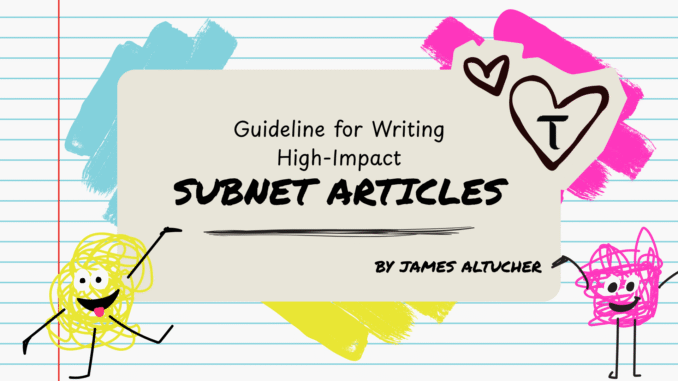
This guide outlines a simple, step-by-step approach to writing articles, especially those about Bittensor subnets or similar topics. The goal is to create engaging, story-driven content that hooks readers, solves problems, and drives action (like investing). Follow these principles to make your articles clear, compelling, and effective.
1. Start with the Core Structure: Tell a Story, Not a List
- If it bleeds, it leads: Begin with a big, relatable problem or dramatic hook. Make it emotional or urgent—something readers can feel (e.g., a parent’s worry about deepfakes harming their child). Avoid boring intros like background debates; jump into the “bleeding” moment.
- Bad: “College has been debated for years…”
- Good: “I learned nothing in college and I’m begging my daughter not to go. It’s a scam.”
- Connect sections like a story: Use a “THEREFORE… BUT…” flow to link ideas. Don’t just list facts (“this happened, then this”). Build tension:
- Problem exists → THEREFORE we need a solution → BUT centralized options fail → THEREFORE decentralized AI (like Bittensor/BitMind) steps in → BUT incentives must align → THEREFORE alpha buybacks or other mechanisms.
- This turns the article into a narrative: “FUCK! THEREFORE… BUT… THEREFORE… BUT…”
Example structure:
- Deepfakes are destroying trust → THEREFORE we need AI to detect them.
- Centralized AI fails → BUT Bittensor enables decentralized detection.
- Incentives are tricky → THEREFORE BitMind uses Alpha token buybacks.
- Key elements for subnet articles:
- What is the subnet? Explain simply—assume the reader knows nothing.
- How does it solve a big, world-shaking problem? Tie it to real-world impact.
- How are miners incentivized? Who are they, and what do they do?
- Who are the customers/users?
- Why invest? Show how alpha holders are aligned with subnet success (e.g., linked incentives/revenue share). Explain why subnet success = TAO success, making alphas/TAO a must-buy while cheap.
2. Write First, Edit Ruthlessly
- Draft the full article focusing on the “meat” (ideas and story).
- [DON’T USE THIS EVERY TIME!] The 90% trick: After writing, delete the first and last paragraphs without overthinking → 90% of the time, the article reads stronger without them. Intros are often mediocre setups, and conclusions are unnecessary goodbyes. This tightens the piece.
- Make it easy to understand: If you don’t fully get it, rewrite until you do. Use simple language; avoid jargon without explanation.
3. The 4 U’s (Copywriting Framework)
Treat articles like ads—copywriters use these to make millions. Ensure your piece hits all four:
- Useful: Solve a BIG problem with value (e.g., how BitMind detects deepfakes to protect society).
- Urgent: Create a sense of now-or-never (e.g., alphas are cheap now, but subnet success will drive prices up 1000%).
- Unquestionable Proof: Back claims with stats or sources (e.g., “BitMind is accurate 88% of the time vs. competitors’ 69%—here’s a study”).
- Ultra-Specific: Detail exactly how it works (e.g., miners use GaN networks; etc.)
- Unique (bonus): Explain why this project is different from competitors (e.g., it’s the only decentralized option with alpha incentives tied to success).
4. Craft a Click-Worthy Title
- Make it irresistible: Use hype that promises big gains or insights (e.g., “This is WHY BitMind is Going Up 1000%” instead of “An Overview of BitMind”).
- Focus on curiosity, urgency, or benefits—if it doesn’t make people click, rework it.
- Example:
- Bad: “BitMind’s AI Subnet Explained”
- Good: “This is WHY BitMind is Going Up 1000%”
- Example:
5. Final Check: Did You Do It Right?
- Starts with a relatable story/problem.
- Builds to the solution via decentralized AI/Bittensor.
- Addresses failures of alternatives and why incentives (like miner emissions or alpha buybacks) make it work.
- Provides proof and specifics.
- Ends strong without fluff.
- Bonus for viral potential: If you’re a little afraid to publish (edgy or bold claims), it might be great. This applies more to general content, but can add edge to financial pieces.
6. Tips for Success
- Review edits from shared Google Docs for style examples.
- Ask questions if unclear—share drafts for feedback.
- Remember: Subnets succeed when alphas align with growth. Great articles help that happen, boosting TAO overall.
An example of a subnet article that gets it right: Why BitMind Could Explode 1000% From Here
7. Quick Checklist Before Publishing
- Did I start with a bleeding problem?
- Did I use “THEREFORE / BUT” to connect sections?
- Did I explain what the subnet is, the problem it solves, miners, customers, investors?
- Did I apply the 4 U’s (Useful, Urgent, Proof, Specific, Unique)?
- Is my title click-worthy?
- Does the article feel bold enough to make me hesitate before hitting publish?
Follow this consistently for articles that engage, inform, and convert readers.




Be the first to comment